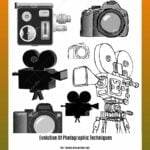Embark on a captivating odyssey through the invention of the camera, a groundbreaking technology that transformed our perception of the world. From the rudimentary optical experiments that sparked its conception to the remarkable advancements that propelled image capture to new heights, this article delves into the fascinating evolution of the camera, capturing the essence of human ingenuity and its enduring impact on society.
Key Takeaways:
- Camera Obscura: Invented centuries ago, it’s a natural phenomenon that creates an inverted image through a hole onto a surface.
- Ibn al-Haytham: An Arab physicist who contributed greatly to understanding the camera obscura.
- Early Photography (1816 and beyond): Nicéphore Niépce captured the first successful photograph using a camera obscura.
- Daguerreotypes and Calotypes: Practical photography methods developed in the 1830s and 1840s.
- Dry Plates (1871): Gelatin-based plates that made photography more convenient and allowed for portable cameras.
- Photographic Film (1880s): George Eastman invented film, making photography more accessible and portable.
The Invention of the Camera:

Our world would be a far different place without the invention of the camera, a device that forever transformed the way we capture and preserve memories. The journey of its invention is a captivating tale of human ingenuity, scientific exploration, and the relentless pursuit of capturing the world through a lens.
Step by Step Evolution of the Camera
1. Camera Obscura: The foundation of modern photography lies in the simple, yet remarkable natural phenomenon known as the camera obscura. A small aperture projects an inverted image of the outside world onto a surface, allowing us to see the world from a unique perspective.
2. Alhazan and Camera Obscura Explorations: Arab physicist Ibn al-Haytham (965-1040 AD) made significant contributions to understanding the camera obscura. His writings explored its principles, paving the way for later advancements in optical technology.
3. Birth of Photography: The year 1816 marked a pivotal moment with the work of Nicéphore Niépce. Using a camera obscura, he captured the first partially successful photograph of a camera image, a pioneering step in the invention of the camera.
4. Daguerreotypes and Calotypes: The 1830s and 1840s saw the emergence of practical photographic processes developed by Louis Daguerre and William Henry Fox Talbot. Daguerreotypes and Calotypes offered more defined and permanent images, capturing the world in a way never seen before.
5. Dry Plates Revolutionize Photography: In 1871, the introduction of gelatin-based dry plates revolutionized photography. These plates allowed for more convenient and portable cameras, making photography more accessible to the masses.
6. Photographic Film: The Pinnacle of Accessibility: George Eastman’s invention of photographic film in the 1880s marked a breakthrough in the invention of the camera. Paper and later celluloid film made photography truly mobile, further democratizing image capture.
Do you wish to know the complete history of photography and the evolution of photographic techniques ? Then go ahead and click on the links.
Early Photographic Experiments: Capturing Light and Shadow

In the realm of innovation, the dawn of photography stands as a captivating chapter, where the interplay of human ingenuity and scientific discovery forever altered our perception of the world. Early photographic experiments laid the foundation for this transformative technology, paving the way for capturing moments in time and preserving our visual legacy.
Silver Salts and the Birth of Light Sensitivity
The journey began in 1727 when German professor Johann Heinrich Schulze stumbled upon a remarkable phenomenon. He observed that silver salts, when exposed to light, underwent a darkening process. This discovery became a cornerstone for harnessing the elusive power of light to create images.
From Daguerreotypes to Calotypes
In 1826, French inventor Nicéphore Niépce etched his name in photographic history by capturing the world’s first permanent photograph. Using bitumen on a pewter plate, Niépce opened the door to capturing enduring images. A decade later, Louis Daguerre introduced the daguerreotype process, which utilized iodized silver plates to create clear and detailed images.
Not to be outdone, Henry Fox Talbot devised the calotype process in 1841. Employing paper negatives, this technique enabled photographers to produce multiple prints from a single negative.
The Wet Collodion Revolution
Frederick Scott Archer’s invention of the wet collodion process in 1851 marked a significant leap forward. Collodion, a protective layer on glass plates, combined with silver nitrate, produced sharper and more detailed images.
The Birth of Roll Film and Beyond
The advent of roll film by George Eastman in 1884 brought photography to the masses. Portable cameras, made possible by the flexibility of roll film, democratized image capture and fueled the proliferation of handheld photography.
Digital Revolution
The late 20th century ushered in the digital photography era. Eliminating the need for film, digital cameras allowed for instant image capture, editing, and sharing, revolutionizing the way we document our experiences.
Key Takeaways:
- Early photographic experiments harnessed the light-sensitive properties of silver salts.
- The daguerreotype and calotype processes played pivotal roles in the development of permanent photography.
- The wet collodion process significantly improved image quality.
- Roll film and digital photography transformed photography into a portable and accessible medium.
Relevant URLs:
- History of Photography | Britannica
- A Brief History of Photography- The Photography Timeline
Collodion and Daguerreotype: Rival Photographic Processes
In the realm of photography’s dawn, two rivals emerged: collodion and daguerreotype. Both processes aimed to capture light and immortalize moments, but each traversed distinct paths.
Collodion: Fast and Impermanent
Collodion, a gelatin-like substance, transformed photography. It allowed images to be taken on glass plates, making the process less expensive and more accessible. However, it was notoriously time-sensitive.
Daguerreotype: Elegant but Limited
The daguerreotype, invented by Louis Daguerre, employed a silver-coated copper plate. Its images were clear, sharp, and notably permanent. Yet, the process was more complex, requiring specialized equipment and materials.
Key Takeaways:
- Collodion:
- Used glass plates coated with collodion
- Fast process
- Images were negative, requiring subsequent printing
- Wet process, meaning the plate had to be developed immediately
- Daguerreotype:
- Used silver-coated copper plates
- Complex, multi-step process
- Images were positive, one-of-a-kind
- Dry process, allowing for longer exposure times
Relevant URL Sources:
- Collodion Process – Art21
- The Wet Collodion Process: A Historical Overview
The Rise of Modern Photography and Technological Advancements
Key Takeaways:
- Camera Obscura: Precursor to photography, projecting images onto a surface through a small hole.
- Light Sensitivity: Discovery of silver salts’ darkening upon light exposure led to photography’s foundation.
- Daguerreotype: Early photographic process using iodized silver plates, producing clear and permanent images.
- Modern Photography: Advances like dry plates and film made photography more convenient and accessible.
- Digital Photography: Eliminated film, enabling instant image capture and editing.
The Camera Obscura: Genesis of Image Projection
The camera obscura, a dark chamber with a small hole, projected images onto a surface since ancient times. It allowed for inverted image observation. Arab physicist Alhazan advanced its understanding in the 10th century.
Light’s Magic and Silver’s Reaction
In 1727, German professor Johann Heinrich Schulze discovered the darkening of silver salts upon light exposure. This laid the groundwork for photography. Nicéphore Niépce harnessed this phenomenon in 1826, capturing the first semi-successful photograph using bitumen on a pewter plate.
Daguerre’s Dawn of Clarity
Louis Daguerre’s daguerreotype process, introduced in 1839, marked a significant breakthrough. It utilized iodized silver plates to create clear and permanent images. This advancement established photography as a viable medium.
Dry Plates and Film: Photography’s Accessibility Revolution
Dry plates (1871) and George Eastman’s photographic film (1880s) revolutionized photography’s convenience. Dry plates, gelatin-based, allowed for longer exposure times. Film’s portability made photography accessible to a wider audience.
Digital Photography: Capturing Moments Instantly
Digital photography, developed in the late 20th century, eliminated the need for film. It enabled instant image capture and editing, further transforming how we capture and share memories.
Relevant URLs:
- History of Photography | Britannica
- A Brief History of Photography- The Photography Timeline
FAQ
Q1: What was the fundamental principle behind the early camera obscura?
A1: The camera obscura, the precursor to the camera, projected an inverted image onto a surface through a small aperture based on the natural phenomenon of light projection.
Q2: How did Ibn al-Haytham contribute to the understanding of the camera obscura?
A2: As an Arab physicist, Ibn al-Haytham provided significant insights into the principles of the camera obscura, making important contributions to our knowledge of its functioning.
Q3: Who is credited with creating the first partially successful photograph?
A3: Nicéphore Niépce is recognized for capturing the first partially successful photograph in approximately 1816, using a camera obscura and a bitumen-based process.
Q4: What was the significance of the daguerreotype and calotype processes in the history of photography?
A4: Daguerreotypes and calotypes, practical photographic processes developed in the 1830s-1840s, played a pivotal role in the advancement of photography, making it more accessible and versatile.
Q5: How did the invention of photographic film and dry plates revolutionize photography?
A5: The introduction of photographic film and dry plates in the 19th century revolutionized photography, making it more portable and convenient, paving the way for widespread adoption and new photographic applications.
- Discover Long Black Pepper: Flavor & Health Benefits - April 25, 2025
- Shocking Twists: The Grownup Review: Unreliable Narration - April 25, 2025
- A Quiet Place Book vs Movie: A Deep Dive - April 25, 2025
















